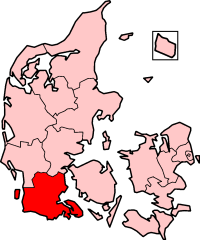South Jutland County
| Sønderjyllands Amt | |
| Basic Facts | |
| County seat | Aabenraa |
| Area | 3,938 km² |
| Inhabitants | 252,433 (2006) |
| Map | |
 | |
South Jutland County (Danish: Sønderjyllands Amt) is a former county (Danish: amt) on the south-central portion of the Jutland Peninsula in southern Denmark.
The county was formed on April 1, 1970, comprising the former counties of Aabenraa (E), Haderslev (N), Sønderborg (SE), and Tønder (SW). The county was abolished effective January 1, 2007, when the Region of Southern Denmark was formed.
Following the reunification of the region with Denmark, the Church of Denmark elevated Haderslev to a diocese in 1923[1] and divided the region between the dioceses of Ribe (W) and Haderslev (E). This arrangement remains in effect.
Short description of South Jutland
South Jutland county is also known as Northern Schleswig (Danish: Nordslesvig, German: Nordschleswig). The name refers specifically to the southernmost 50 kilometers of the Danish part of the Jutland Peninsula that formerly belonged to the former Duchy of Schleswig (Danish: Slesvig or Sønderjylland); a Danish fief under the Kings of Denmark.
Denmark lost the Duchy of Schleswig, as well as the German Duchies of Holstein and Lauenburg, to Prussia and Austria in 1864 in the Second War of Schleswig. Following Austria's defeat in the Austro-Prussian War (1866), all three provinces were annexed to Prussia. Following the defeat of Germany in World War I, the Allied powers organised two plebiscites in Northern and Central Schleswig on 10 February and 14 March 1920, respectively. In Northern Schleswig 75% voted for reunification with Denmark and 25% for staying with Germany. In Central Schleswig the situation was reversed with 80% voting for Germany and 20% for Denmark. No vote ever took place in the southern third of Schleswig, as the result was a foregone conclusion. On 15 June 1920, Northern Schleswig was officially reunited with Denmark. It is the only one of the German transfers of territory after World War I that the Nazis did not dispute.
Central Schleswig chose to remain with Southern Schleswig as part of Germany and is today a part of the German state of Schleswig-Holstein.
A small ethnic German minority still lives in South Jutland county - predominantly in and near the towns of Tønder and Aabenraa (German: Tondern and Apenrade).
Important settlements: Sønderborg (27,000), Aabenraa (15,000), Haderslev (21,000 people) and Tønder (8,000).[2]
1970 Borders
As reconstituted in 1970, South Jutland County had slightly different borders to the area gained from Germany in 1920: the towns of Hejle, Taps and Vejstrup (which were Danish throughout the period 1864 to 1920) were included in its jurisdiction, whereas Spandet, Roager and Hviding (German from 1864-1920) were included in the neighbouring 1970-2006 county of Ribe.[3]
Insignia
The coat of arms of South Jutland County was designed in 1980 and is derived from the historic coat of arms of Schleswig which in turn is derived from the national coat of arms of Denmark. The inspiration for the Dannebrog pennant was a 13th-century seal used by Erik Abelsøn, Duke of Schleswig.
List of County Mayors
| From | To | County Mayor |
|---|---|---|
| April 1, 1970 | December 2, 1981 | Erik Jessen (Venstre) |
| December 2, 1981 | July 1, 2000 | Kresten Philipsen (Venstre) |
| July 1, 2000 | December 31, 2006 | Carl Holst (Venstre) |
Municipalities (1970-2006)
References
Coordinates: 55°02′40″N 9°24′52″E / 55.04444°N 9.41444°E